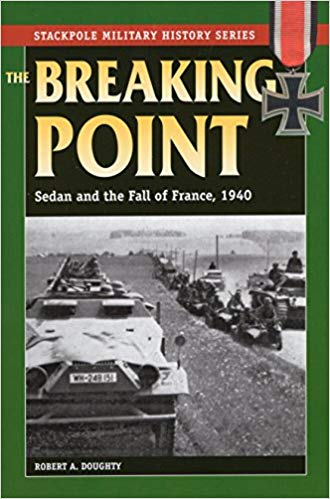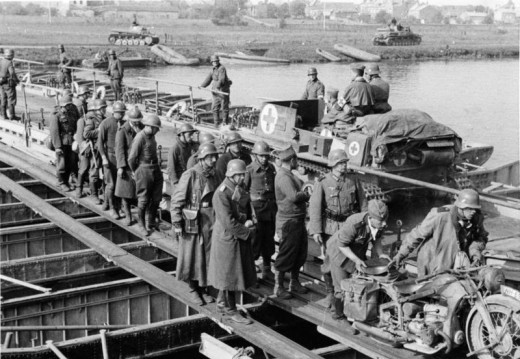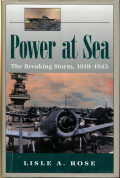The Breaking Point: Sedan and the Fall of France

If the Battle of France continues to be a controversial and stirring subject, one which reverberates in the popular memory and shapes our views of France and Germany, at least if one is genuinely interested in understanding what happened in the conflict and why the defeat of France was so crushing and quick, there is no shortage of material available upon the subject. In this regards, The Breaking Point: Sedan and the Fall of France, 1940, by Robert A. Doughty, joins a litany of other books upon the same subject - The Seeds of Disaster by the same author, To Lose a Battle, France 1940, and French Foreign and Defense Policy 1918-1940: The Decline and Fall of a Great Power are just some of the Anglophone books available on the subject, not counting the vast French literature available - above all else the near-mythical L’Étrange Défaite of French historian Marc Bloch - and these just the books which are devoted to the military or foreign policy aspects which led up to and involved the battle, not even taking into account the endless list of books devoted to French internal history. What sets The Breaking Point apart from the other books, including Doughty's own work, is that it is in many senses a near micro-history: it is devoted to a singular, albeit highly pivotal battle which played such a critical role in the collapse of French defenses and the ultimate defeat of France: the Battle of Sedan in 1940. Here a devastating German armored, infantry, and air attack succeeded in crushing French defensive forces, followed by a drive to the sea which cut off the best part of the French army, sealing the fate of the Battle of France. Along the way Doughty uses the battle to illustrate the broader principles and doctrines which animated the two sides, and produces an account of the battle that for those who are seriously interested in the intricate unfurling of affairs, is an unmissable chance to learn it down to the most exacting details.

The structure of The Breaking Point is elegant in its simplicity: a chronological look at the Battle of Sedan, with alternating French and German perspectives on it. Initially it discusses the differing doctrine and organization of the two sides, then proceeds to cover the development of the two armies in the lead up to the battle. It also discusses French intelligence and where they thought that the German attack would take place, and the development of their plans and general strategy for the upcoming battle. On the German side, some of the preparation undertaken is also discussed, but principal focus is about how the Germans arrived at the plan to break through at Sedan with a subsequent "sickle cut" planned to the Atlantic that would cut off the French army.
The unfurling of operational affairs starts with the German strike through the Ardennes, covering their rapid move through it and the light, if not insignificant, resistance provided by Belgian chasseurs ardennais and French cavalry units. It then deals with the nature of the French divisions that would be the main forces stationed at Sedan, alongside what sort of efforts they made to prepare themselves for the coming, if unknown to them, battle - such as their training or their construction of fortifications. Following this it covers the actual assault upon the French positions along the Meuse river, looking at it from both sides. Resultant French tactical counter attacks and the German consolidation of the bridge head receive their due focus, followed by the German decision to exploit and expand their effort by moving to the West, and the French efforts to move units on the operational level to respond to them - harmed by their failure to recognize where the German attack was destined, and also by their incapacity to effectively determine what the Germans were doing and their chaotic and poorly undertaken responses to the battle.
This is followed by the description of the fighting to the West, catastrophic for the French, the failure of their strategic movements into the region, and the resulting conclusion which looks at the doctrine behind the two armies and discusses the growth of various myths and ideas about the battle and seeks to dispel them.
In its organization and construction, this makes the book very simple, almost deceptively so. The level of detail of these operations and fighting is almost byzantine, and the intimate familiarly of Doughty with both the German and French sides of the battle is on display, where he used extensive amounts of primary documents from both to put together his narrative. Using the mirror approach of portraying what happened on the French and German side in respective chapters, provides an excellent way to be able to understand the differing interpretations of how the battle was unfolding - sometimes with almost comical alienation from reality on the French side, although the extent of their disaster makes it much less than comic indeed. Furthermore Doughty includes a wide array of quotations from actual operations in the battle, something which helps it become more real and understandable to the reader, and complements his highly extensive discussion of operational movements and plans drawn up by the French and Germans. Furthermore, his extensive look into the background of the French infantry divisions that shattered at Sedan is an intriguing one: most of the time commentators are content to merely write the 55th division off as a bad, Category B, division, but with illuminating detail Doughty paints a more nuanced detail, and thus enables much more interesting and serious questions to be posed about why this division fell apart under the German onslaught.
But this very level of detail is for most readers, unnecessary. For most interested in the subject, the work of Alistair Horne with his impressive and magisterial "To Lose a Battle", is more than sufficient, with a much broader focus, brilliant writing, larger context, and still providing excellent levels of detail about the operations at Sedan. Indeed, at times Horne's book is more eye-opening about the fighting which occurred so decisively there, with an overall better ability to relate the situation as seen on the ground by the soldiers, and sometimes even mentioning details that Doughty's book misses - I can think for example, about missed chances by the French artillery to blunt the German attack across the Meuse, certain shelling operations by long ranged French artillery, and more detailed descriptions of the air operations. Indeed, the air operation section is one where I feel more could have been fleshed out, with more analysis of its operational, morale, and tactical effects. Nevertheless as a whole the level of detail furnished by Doughty's book is incredible and highly impressive, and certainly enables one to have an even more firm grasp of the fighting which occurred in the 1940 campaign here: the main thing is that it is simply put not needed for the average reader.
This does not I feel, take away from accomplishment of Doughty. A book should be judged on whether a write achieves his objective, and to some extent how important useful that objective is. Doughty's book set out to achieve an objective of writing a highly detailed and complete history of the battle of Sedan that would also enable him to reflect upon some of the differences in doctrine between the French and German armies, which is well taken up in the final chapter (although here some elements might seem strange - for example, he decreases the praise given to German aircraft and writes that German artillery also played an important role, but reference to German artillery is rather limited throughout the book, and the aircraft manifestly did play an important role and the French recognized such - although the role of the Stuka has been so overemphasized about the battle that it is hard to claim it to not be so, and certainly in any case Doughty convincingly demonstrates that the humble infantryman too, has much claim to credit in this battle) In this regards, he succeeded magnificently - the fact that his work is so specialized and only really useful to a relatively small circle of people not taking away from that. For those who are seriously, highly interested and determined to know everything about the Battle of Sedan, this book, in conjunction with To Lose a Battle, makes for invaluable reading, albeit one that needs books that provide for the larger context into which the battle was placed.
© 2019 Ryan Thomas









